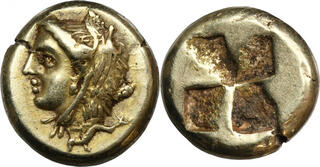| Salon Numizmatyczny Mateusz Wójcicki > Auction 13 | Auction date: 9 March 2024 |
| Lot number: 10008 Price realized: 570 EUR (Approx. 625 USD) Note: Prices do not include buyer's fees. | Show similar lots on CoinArchives Find similar lots in upcoming auctions on |
| Lot description: Greece, Phocaea, Electron Hekte Nicely preserved hekte, struck from an electron, a naturally occurring alloy of gold and silver. The ancient Greeks also called them 'white gold'. Greece, Phocaea, Electron Hekte 387-326 BC Obverse: head of Hercules facing left Reverse: incusum square Gold, diameter 10 mm, weight 2.54 g Earliest known electron coins, Lydian and East Greek coins beneath the Temple of Artemis in Ephesus. They are now dated to the last quarter of the 7th century BC (625–600 BC). The electron was much better for minting coins than gold, decisions because it was harder and more durable, but also because the refining techniques were not very important. The electron is exposed to gold and silver, but sometimes traces of platinum, copper, and other metals can be found in it. An analysis of the hardware of the electron in ancient Greek coins from around 600 BC shows that the gold content of Phocaya skin coins is around 55.5%. In the early classical period, the gold content of the electron ranged from 46% in Phokai to 43% in Mytilene. The earlier coins of these titles, dated 326 BC, later portfolio content 40% to 41%. During the Hellenistic period, the Carthaginians issued electron coins with declining gold content. Ładnie zachowane hekte, wybite z elektronu, naturalnie występującego stopu złota i srebra. Starożytni Grecy nazywali je również 'białym złotem'. Grecja, Fokaja, Hekte elektronowe 387-326 pne Awers: głowa Herkules w lewo Rewers: kwadrat incusum Złoto, średnica 10 mm, waga 2.54 g Najwcześniejsze znane monety elektronowe, to monety lidyjskie i wschodnio-greckie znalezione pod Świątynią Artemidy w Efezie. Obecnie są datowane na ostatnie ćwierć VII wieku pne (625–600 pne). Elektron był znacznie lepszy do bicia monet niż złoto, głównie dlatego, że był twardszy i trwalszy, ale także dlatego, że techniki rafinacji złota nie były wówczas zbyt rozpowszechnione. Elektron składa się głównie ze złota i srebra, ale czasami można w nim znaleźć ślady platyny, miedzi i innych metali. Analiza składu elektronu w monetach starożytnej Grecji z około 600 roku pne pokazuje, że zawartość złota w monetach emitowanych przez Fokaję wynosiła około 55,5%. We wczesnym okresie klasycznym zawartość złota w elektronie wahała się od 46% w Fokai do 43% w Mytilene. W późniejszych monetach z tych obszarów, datowanym na 326 rok pne, zawartość złota wynosiła średnio 40% do 41%. W okresie hellenistycznym Kartagińczycy emitowali monety elektronowe o regularnie malejącej zawartości złota. Reference: Bodenstedt 107, SNG Copenhagen 1029 Grade: XF- Greece Phocaea Hekte Starting price: 355 EUR |  |


